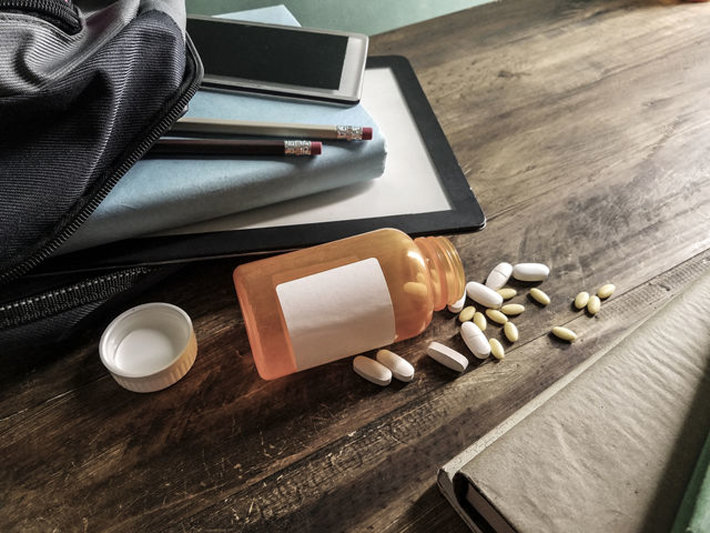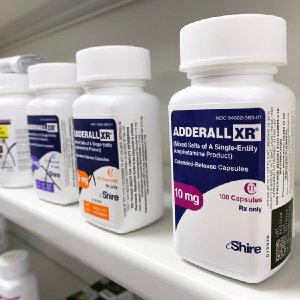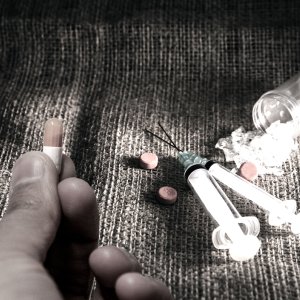So-Called “Study Drugs” Commonly Mis-Used

There’s significant controversy surrounding the use of stimulant drugs in the treatment of problems lumped under the general heading of “attention deficit hyperactivity disorder” or ADHD. Not everyone agrees that a diagnosis of this disorder should be treated with medications.
Whether it should or not, one thing is certain, the popular practice of treating this disorder with stimulant prescription drugs has put a huge quantity of these drugs into circulation among our youth and young adults. These stimulants have acquired a reputation for helping enhance a student’s ability to succeed academically. And that has led to widespread diversion of the drug to students who never received a prescription, or to students faking symptoms to get their own prescription.
What are “ADHD Drugs”?
Calling a medication an ADHD drug is shorthand for any drug that is commonly prescribed for young people manifesting symptoms such as inattention and hyperactivity, impulsive behavior, etc. The most frequently prescribed drugs are methylphenidate, best known by its brand name Ritalin, and a combination of four salts of amphetamine brand-named as Adderall. These are both strong stimulants. A less-popular non-stimulant drug used in this situation is atomoxetine, which is brand-named Strattera.
A list of other drugs with their brand names and generic names follows. For some of these drugs, there are both extended-release (ER or XR) and fast-acting forms available.
Stimulants:
- Dexedrine (dextroamphetamine)
- Desoxyn (methamphetamine)
- Zenzedi (dextroamphetamine)
- Focalin (dexmethylphenidate)
- Methylin (methylphenidate)
- Dyanavel (amphetamine sulfate)
- Evekeo (amphetamine sulfate)
- Dexedrine Spansule (dextroamphetamine)
- Mydayis (dextroamphetamine and amphetamine)
- Vyvanse (lisdexamfetamine)
- Aptensio XR (methylphenidate)
- Concerta (methylphenidate)
- Cotempla XR (methylphenidate)
- Metadate ER (methylphenidate)
- Quillichew ER (methylphenidate)
- Quillivant XR (methylphenidate)
Non-Stimulants:
- Catapres (clonidine)
- Tenex (guanfacine)
- Kapvay (clonidine)
- Intuitive (guanfacine)
- Tenex (guanfacine)
What Effects Do These Drugs Have?

People who believe these drugs offer a solution to problems like inattention and lack of focus say that these drugs help students stay on task so they can learn better. Many other individuals point to the dangerous side effects of these drugs. A report from Harvard Medical School notes these problems:
- Elevated blood pressure
- Seizures
- Heart irregularities
- Growth suppression
- Sudden cardiac death
- Chest pain
- Heart attacks
- Strokes
- Arrhythmias
Prescribing information for Adderall, for example, as approved by the Food and Drug Administration notes that the side effects can include:
- New or worse behavior and thought problems
- New or worse bipolar illness
- New or worse aggressive behavior or hostility
- New psychotic symptoms (such as hearing voices, believing things that are not true)
- New manic symptoms
In addition to side effects, a commonly-observed problem with these drugs is diversion, abuse and addiction. Of course, a person abusing these drugs is just as likely to suffer the same adverse side effects. If they dose more frequently or at higher doses than a doctor would recommend, they may encounter these effects more often and more dangerously.
How Did We Get Into This Situation?
The stage is set for abuse with widespread prescribing of these drugs at young ages. Sometimes very young ages. Another report noted the side effects of these stimulants on pre-schoolers: sadness, irritability, clinginess, insomnia, and anorexia. In fact, a 2006 report on prescribing these drugs stated that 2% of three-to-five-year olds manifest symptoms that might cause a physician to prescribe these drugs.
The annual survey Monitoring the Future provides a detailed look at how many of our children are taking these drugs, either as prescribed or as a result of diversion to abuse. Their findings showed:
How many 8th, 10th and 12th graders have ever taken these medications after having them prescribed?
- 8th: 9.8%
- 10th: 9.8%
- 12th: 11.1%
How many of these youth were taking them at the time of the survey?
- 8th: 3.8%
- 10th: 4.4%
- 12th: 5.0%
Misuse of These Drugs

Among those youth not planning to attend college, misuse of Ritalin was significantly higher than use by college-bound 8th and 10th graders, and slightly higher among 12th graders. This was true for Adderall as well, with 6% of noncollege-bound 8th graders misusing the drug, and 2% of college-bound students.
There’s a separate report from the Monitoring the Future survey focusing on college-aged students. Among adults aged 19 to 30, nonmedical use is relatively low. Nonmedical use of Ritalin ranges between 0.1% and 2.4%.
Adderall use is higher:
- Among 21-22 year-olds: 9.8%
- 23-30 year-olds: 6.0 to 7.5%
This survey states: “The higher prevalence among those in their early 20s is consistent with the interpretation that initially Ritalin and perhaps now Adderall are sometimes used by college students because they believe it will enhance their academic performance.”
Another study from 2016 reported that 10.7% of college students used Adderall nonmedically during the prior year. But that’s only one estimate. The answer seems to depend on who is doing the survey and where they are doing it. Estimates vary from 5.3% to 33.8% among studies of college students.
This study stated: “One finding that is highly consistent across all studies of college students is that the primary motive for NPS [nonmedical use of prescription stimulants] is to improve academic performance. Students report that NPS is driven by study motives, such as increasing the ability to concentrate while studying or by increasing the amount of time they can sustain focus.”
But a comparison of the grade point average among misusers and those who didn’t misuse did not find a difference in their grades.
In yet another study from Ohio State’s Center for the Study of Student Life found that 25% of undergraduates reported that they had used prescription drugs of any type for non-medical reasons in their lifetimes. About 18% of these students identified a stimulant as the drug they misused. And among these students, 84.9% said that it was to help them study or improve their grades.
Post-College Misuse
There are no surveys of professionals or those over 30 years of age to find out how many of them are misusing these drugs. However, a 2015 New York Times article sheds some light on the extent of this misuse. This article states: “Reliable data to quantify how many American workers misuse stimulants does not exist, several experts said. But in interviews, dozens of people in a wide spectrum of professions said they and co-workers misused stimulants like Adderall, Vyvanse and Concerta to improve work performance.” Most of those interviewed for this article obtained their drugs by faking the symptoms of ADHD and getting a doctor’s prescription for one of the drugs listed above.
In the same article, the chairman of neurology at Pennsylvania Hospital in Philadelphia noted that when youth begin using this drug in high school, it’s normalized for them and not a big deal for them to continue using them when they get jobs. The article also observes that doctors note the possibility of anxiety, addiction and hallucinations when high doses of the drug are used.
Recreational Use?
About recreational use of these drugs, there is even less information. National surveys of drug use do not ask users for the purpose of their misuse of prescription drugs.
However, there is some information available. A small study of undergraduates found that 35.5% had used prescription amphetamines illicitly. Of the students, most were using them to try to get an academic advantage. But 19.3% reported using them in combination with alcohol for recreational reasons.
A 2016 study of younger misusers (8th and 10th graders) found that those misusing stimulants at this age were very likely to also misuse alcohol, tobacco, and marijuana which led the authors to conclude that their use was recreational.
Misuse of stimulants such as Ritalin and Adderall doesn’t make the headlines like use of opioids or marijuana does. But it is a dangerous practice at any age, no matter what the misuser’s intended purpose is.
Sources:
- https://www.ncbi.nlm.nih.gov/pmc/articles/PMC2957280/
- https://www.health.harvard.edu/adult-and-child-adhd/adhd-update-new-data-on-the-risks-of-medication
- https://www.fda.gov/media/94353/download
- https://www.ncbi.nlm.nih.gov/pmc/articles/PMC2957280/
- http://www.monitoringthefuture.org/pubs/monographs/mtf-vol1_2019.pdf
- http://www.monitoringthefuture.org/pubs/monographs/mtf-vol2_2019.pdf
- https://www.ncbi.nlm.nih.gov/pmc/articles/PMC5140739/
- https://www.cleveland.com/metro/2015/10/college_students_say_it_is_eas.html
- https://www.nytimes.com/2015/04/19/us/workers-seeking-productivity-in-a-pill-are-abusing-adhd-drugs.html
- https://www.tandfonline.com/doi/abs/10.1080/13548500220139386
- https://pubmed.ncbi.nlm.nih.gov/27918861/


 ®
®